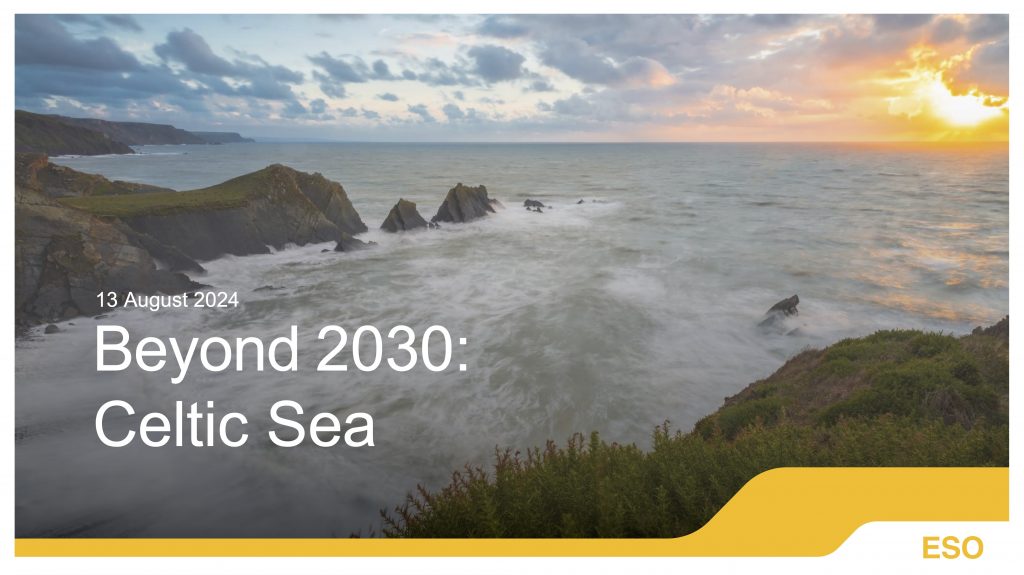Today, 13th Aug, the Electricity System Operator (ESO) has unveiled Beyond 2030: Celtic Sea, its recommended design to connect up to 4.5GW of floating offshore wind renewable energy capacity, enough green power for over four million homes.
The recommended design connects up to 3GW into two locations in South Wales and up to 1.5GW into the South West of England, with each of the three proposed offshore wind farms (also known as Project Development Areas, or PDAs) having its own connection to the onshore electricity network. The proposals are for one high voltage direct current (HVDC) connection into a potential new South Wales Connection Node, and two connections utilising high voltage alternating current (HVAC) technology into Carmarthenshire and North Devon.

A number of shortlisted designs were rigorously assessed against four design objectives – impact on local communities and the environment, cost to the consumer, deliverability, and operability – allowing the ESO to arrive at a recommended design that carefully balances these considerations. The recommendation presents less impact on the environment and community than others that were considered during the design process, and no new overhead lines are indicated to connect the offshore wind.
Proposals also make good use of the current wider transmission infrastructure compared to other options, and – in the case of Carmarthenshire and North Devon – recommend regions with an already identified need for a substation, or an already-proposed substation (for example Llandyfaelog in Carmarthenshire). This alignment with other infrastructure needs could lead to a more coordinated approach to locating new substations.
The proposals are an enabler of The Crown Estate’s Celtic Sea Floating Offshore Wind Leasing Round 5, a nationally significant 4.5 GW of floating offshore wind power that will connect directly into the transmission network – one of the largest floating wind initiatives in the world.
Independent research indicates that Leasing Round 5 and the associated supply chain could create 5300 permanent jobs during the construction phase of the projects and drive up to £1.4billion of economic activity.
The Celtic Sea design is unique to other network design exercises previously undertaken by the ESO as developers have yet to bid for the opportunity to develop in the three areas of seabed identified by The Crown Estate for this leasing round. This new approach to the sequencing will allow developers to make a more informed bid based on the network recommendations, reducing risk.
It is also allowing the ESO to take a new approach on the connections queue for this Round 5 capacity by effectively ringfencing the 4.5GW in advance, so that we can proceed efficiently with the connection contract process when the seabed Agreements for Lease are awarded by TCE.
The ESO has undertaken this assessment as a continuation of its Holistic Network Design (HND) publications Pathway to 2030 and Beyond 2030, which charted a course to facilitate up to 86GW of offshore wind up to and throughout the 2030s.
The Beyond 2030: Celtic Sea design creates opportunities for the South Wales and South West regions to continue to play an important part in Great Britain’s green industrial revolution, with the connections into the region providing a catalyst for future coordination with green energy developments in those areas. The ESO worked with a group of representatives from local councils across South Wales and the South West to discuss optioneering exercises and invite feedback to be considered as part of the design development.
Following the proposals, the ESO will work with the host transmission owner (TO) – which is National Grid Electricity Transmission (NGET) in England and Wales – to progress relevant works for this recommendation as it advances into the detailed network design stage.
Commenting, the ESO’s director of strategic energy planning and chief engineer Julian Leslie said, “Offshore wind is vital to achieving the Government’s target for clean power by 2030, sustaining energy security and achieving net zero by 2050, so it is a really positive development that this is the first time an offshore wind leasing round will have been launched with a recommended high-level network design in place.
“We have undertaken a rigorous process, in consultation with a range of stakeholders, to design the network needed to connect enough renewable capacity to power four million homes. Our proposal has additional potential as a catalyst for coordination with future green energy developments in South Wales and South West England into the future.
“We are committed to delivering a clean, secure, decarbonised electricity system as set out by Government and Devolved Governments, through working collaboratively across all parts of the energy sector, government, the regulator and within our communities across Great Britain.”



